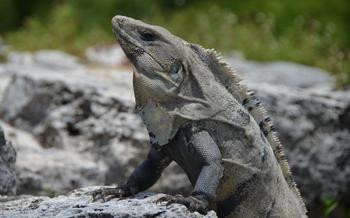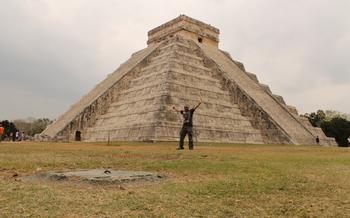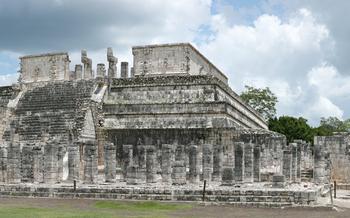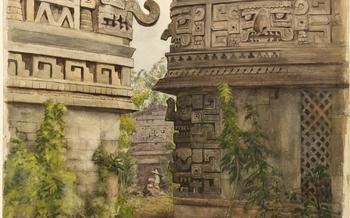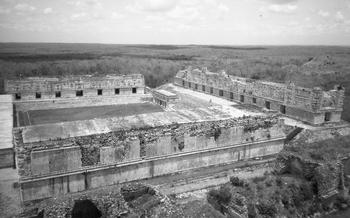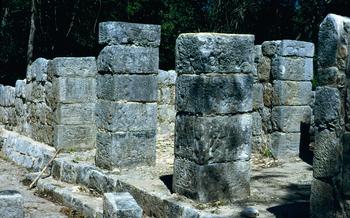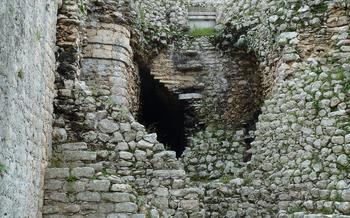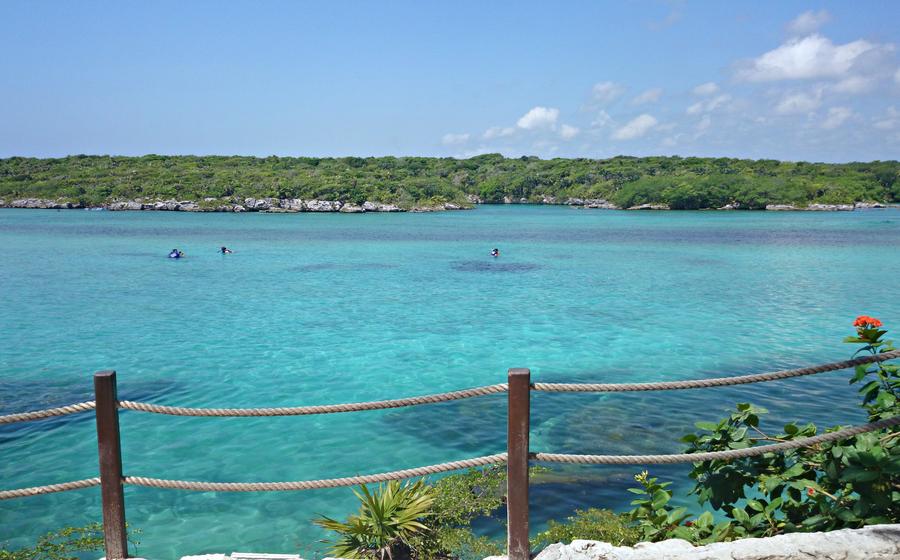
Museum of the Maya Culture
- Xel-Há, a Natural and Cultural Paradise:
- The Museum of the Maya Culture
- Exploring the Museum's Exhibits
- Maya Civilization Origins
- Personal Anecdote
- Maya Art and Architecture
- Maya Writing and Calendar
- Maya Religion and Rituals
- Maya Trade and Economy
- Maya Collapse and Legacy
- Guided Tours and Educational Programs
- Souvenirs and Cultural Crafts
- Accessibility and Facilities
- Tips for Your Visit
- Insider Tip: Uncovering the Secret Cenote
Xel-Há, a Natural and Cultural Paradise:
Xel-Há is a picturesque paradise nestled in the heart of the Riviera Maya, on the northeastern coast of the Yucatán Peninsula in Mexico. This enchanting natural and cultural reserve was once a sacred site for the ancient Maya, who revered it as a place of great beauty and spiritual significance. Its name, Xel-Há, means "where the waters are born" in the Maya language, reflecting the abundance of freshwater springs and cenotes that converge here, creating a unique ecosystem of crystal-clear lagoons, verdant mangroves, and diverse wildlife.
Getting to Xel-Há is a breeze, as it is conveniently located just a short drive from the popular tourist destinations of Cancun and Playa del Carmen. Whether you choose to embark on a guided tour or make your way there independently, the journey offers breathtaking views of the lush Mayan jungle, with its towering trees and vibrant flora.
As a natural reserve, Xel-Há is home to an incredible diversity of plant and animal life. From the majestic sea turtles that grace its shores to the colorful tropical birds that flutter among the mangroves, the reserve teems with life. Snorkeling and diving enthusiasts can immerse themselves in the mesmerizing underwater world, where vibrant coral reefs and playful marine creatures await.
One of my most unforgettable experiences at Xel-Há was floating along the lazy river, surrounded by lush vegetation and the gentle sound of flowing water. As I drifted along, I couldn't help but be awestruck by the beauty of this natural paradise, where the harmonious blend of crystal-clear waters, lush greenery, and abundant wildlife created a sense of tranquility and wonder.
The Museum of the Maya Culture
The Museum of the Maya Culture, located within the breathtaking natural beauty of Xel-Há, is a testament to the rich cultural heritage of the ancient Maya civilization. It proudly serves as a gateway to understanding the complex and fascinating world of the Maya, immersing visitors in their history, achievements, and enduring legacy.
The museum's primary objective is to preserve, research, and disseminate knowledge about the Maya civilization, promoting cultural awareness and appreciation. Through its captivating exhibits, interactive displays, and multimedia presentations, the museum offers an immersive journey into the lives and culture of this remarkable civilization.
During my visit to the museum, I was captivated by the innovative and modern design of the building, which seamlessly blended with the surrounding natural environment. The architecture mirrored the spirit of the Maya, harmonizing with the beauty of Xel-Há and creating a truly immersive experience for visitors.
Exploring the Museum's Exhibits
The Museum of the Maya Culture is thoughtfully designed, with a layout that guides visitors through the history and culture of the Maya civilization in a chronological order. As you wander through the galleries, you'll encounter a diverse range of exhibits, including interactive displays, multimedia presentations, and captivating artifacts. Each section is curated to showcase a specific aspect of Maya civilization, from their origins and early settlements to the rise of city-states and their eventual collapse.
One particularly memorable exhibit I came across was a recreation of a Maya marketplace. The marketplace was bustling with activity, with vendors selling a variety of goods, including cacao, obsidian, and jade. Visitors could interact with the exhibit by touching and examining the replica artifacts, offering a glimpse into the vibrant commercial life of the Maya. This hands-on experience brought the past to life and made history feel tangible.
Maya Civilization Origins
The Maya civilization emerged in the Maya Region, which encompasses southeastern Mexico, Belize, Guatemala, and the western portions of Honduras and El Salvador. The origins of the Maya people are shrouded in mystery, but archaeological evidence suggests that they developed from earlier Mesoamerican cultures. One theory proposes that the Maya originated from the Olmec civilization, which flourished in the Gulf Coast region of Mexico from around 1200 to 400 BCE. Another theory suggests that the Maya developed independently from local hunter-gatherer groups.
Agriculture played a crucial role in the development of Maya civilization. The Maya cultivated a variety of crops, including maize, beans, squash, and cacao. They also developed sophisticated irrigation systems to ensure a reliable water supply for their crops. Trade was another important aspect of Maya society. The Maya traded with neighboring cultures, exchanging goods such as obsidian, jade, and cacao.
Personal Anecdote
During my travels in the Maya Region, I had the opportunity to visit the ruins of the ancient Maya city of Tikal. As I stood amidst the towering pyramids and temples, I couldn't help but feel a deep connection to the Maya people. I imagined them going about their daily lives, cultivating their crops, trading with neighboring cities, and performing their elaborate rituals. It was a powerful and moving experience that left me with a profound appreciation for the rich history and legacy of the Maya civilization.
Maya Art and Architecture
The Maya civilization produced a remarkable array of art and architecture that reflected their complex beliefs and worldview. Their art was characterized by intricate carvings, vibrant colors, and symbolic motifs. Maya architecture showcased advanced construction techniques and a deep understanding of geometry and acoustics. The iconic pyramids, temples, and plazas of Maya cities were not only functional structures but also served as expressions of religious and political power. The intricate carvings on these structures depicted scenes from Maya mythology, history, and everyday life, providing a glimpse into their rich cultural tapestry. The Maya also excelled in ceramic arts, producing finely crafted pottery adorned with intricate designs and motifs.
Maya Writing and Calendar
The Maya developed a complex writing system that used a combination of logographic and syllabic symbols. This writing system was used to record historical events, religious rituals, and astronomical observations. The Maya also developed a sophisticated calendar system that was more accurate than the Julian calendar used in Europe at the time. The Maya calendar was based on a 365-day solar year and a 260-day ritual calendar. The Maya believed that time was cyclical, and they used their calendar to track the movements of the sun, moon, and Venus.
Personal Anecdote:
During my visit to the Museum of the Maya Culture, I was fascinated by the exhibit on Maya writing and the calendar. I had never seen anything like it before. The symbols were beautiful and intricate, and the explanations provided by the museum staff helped me to understand the complexity of the Maya writing system. I was also amazed to learn about the accuracy of the Maya calendar. It was truly a testament to the intelligence and ingenuity of the Maya people.
Maya Religion and Rituals
The ancient Maya people held a profound and complex belief system, characterized by a pantheon of gods and goddesses who governed various aspects of their lives. Among the most prominent deities were Itzamná, the creator god; Kukulkán, the feathered serpent god; and Chaac, the rain god. Maya religion played a central role in their daily lives, shaping their social, political, and economic practices.
Priests and shamans were highly respected figures in Maya society, serving as intermediaries between the gods and the people. They performed rituals, ceremonies, and sacrifices to appease the gods and ensure their favor. These rituals often involved offerings of food, incense, and precious objects, as well as the sacrifice of animals or even humans in special circumstances.
The Maya believed that the world was cyclical in nature, and that the actions of the gods and humans could influence the course of events. They developed a complex calendar system that tracked the movements of the sun, moon, and stars, and used it to predict astronomical events and guide their agricultural practices.
Personal Anecdote
During my visit to the Museum of the Maya Culture, I was particularly fascinated by the section dedicated to Maya religion and rituals. The exhibits showcased intricate sculptures, ceramics, and codices that depicted various deities and religious ceremonies. One particularly striking exhibit was a life-size replica of a Maya temple, complete with an altar and offerings. It gave me a glimpse into the sacred world of the Maya and helped me understand the deep spiritual beliefs that guided their lives.
Maya Trade and Economy
The Maya civilization established extensive trade networks that spanned vast distances, connecting far-flung regions throughout Mesoamerica and beyond. This intricate network of trade routes facilitated the exchange of goods, ideas, and cultural influences, contributing to the flourishing of Maya society.
Markets and marketplaces played a pivotal role in the Maya economy. These bustling centers of commerce were vibrant hubs of activity, where merchants and traders converged to buy, sell, and barter a diverse array of goods. Cacao beans, a valuable commodity in Maya society, served as a form of currency, while obsidian and jade, prized for their aesthetic qualities, were highly sought after.
The Maya's trading prowess extended beyond their immediate region. They established trade connections with distant cultures, such as the Olmec and Teotihuacan civilizations, exchanging goods and acquiring exotic materials. This interaction with other societies enriched the Maya's cultural landscape and fostered a vibrant exchange of ideas and innovations.
Anecdote:
During my visit to the Museum of the Maya Culture, I stumbled upon a fascinating exhibit dedicated to Maya trade. It showcased a replica of a bustling marketplace, complete with vendors displaying their wares and customers bartering for goods. The exhibit brought to life the vibrant atmosphere of these ancient centers of commerce and provided a glimpse into the intricate web of trade that connected the Maya world.
Maya Collapse and Legacy
The decline of the Maya civilization, which occurred around the 9th and 10th centuries AD, remains a topic of fascination and debate among historians and archaeologists. While the exact causes are still not fully understood, several theories have been proposed. One prominent theory suggests that climate change, specifically prolonged droughts, played a significant role in the collapse. These droughts would have had a devastating impact on Maya agriculture, leading to food shortages and widespread famine.
Another theory focuses on warfare and internal conflicts within and between Maya city-states. As the Maya civilization grew and expanded, competition for resources and power intensified, leading to conflicts that may have contributed to the decline. Additionally, the rise of new regional powers, such as the Toltecs from central Mexico, may have further destabilized the Maya political landscape.
Disease is also believed to have played a role in the Maya collapse. The introduction of new diseases, possibly brought by European explorers and traders, could have decimated the Maya population and weakened their immune systems. This, combined with the effects of climate change and warfare, would have further contributed to the decline of the Maya civilization.
Despite their collapse, the Maya left behind a rich legacy that continues to influence modern cultures. Their advancements in mathematics, astronomy, and writing systems had a profound impact on the development of Mesoamerican civilizations. Their art, architecture, and religious beliefs have also been a source of inspiration for contemporary artists, writers, and scholars.
Personal Anecdote:
During my visit to the Maya ruins of Tikal in Guatemala, I couldn't help but feel a sense of awe and wonder as I stood amidst the towering pyramids and intricately carved temples. It was a poignant reminder of the Maya civilization's grandeur and the profound impact it had on the region. The collapse of the Maya, while a tragic event, also serves as a testament to the resilience and adaptability of human societies, leaving behind a legacy that continues to captivate and inspire us to this day.
Guided Tours and Educational Programs
The Museum of the Maya Culture offers a variety of guided tours led by knowledgeable and enthusiastic guides who bring the history and culture of the Maya civilization to life. These tours provide visitors with a deeper understanding of the exhibits and allow them to ask questions and engage in discussions. The guides are passionate about sharing their knowledge and ensuring that visitors have a meaningful experience.
In addition to guided tours, the museum also offers educational programs and workshops for visitors of all ages. These programs are designed to promote cultural awareness and provide hands-on learning experiences. Visitors can participate in workshops on Maya arts and crafts, learn about traditional Maya cuisine, or even try their hand at deciphering Maya hieroglyphs. These programs are a great way to deepen one's understanding of Maya culture and history.
One personal experience that highlights the value of guided tours and educational programs at the Museum of the Maya Culture is when I participated in a workshop on Maya weaving. I learned about the different techniques used by Maya weavers and had the opportunity to create my own woven piece using traditional materials and methods. The workshop leader was incredibly knowledgeable and patient, and I left with a newfound appreciation for the skill and artistry of Maya weavers.
Souvenirs and Cultural Crafts
The Museum of the Maya Culture features a well-stocked gift shop where visitors can purchase a variety of souvenirs and cultural crafts to commemorate their visit. From intricately woven textiles and colorful pottery to handmade jewelry and traditional Mayan musical instruments, the gift shop offers a diverse selection of authentic items that showcase the region's rich artistic heritage.
Supporting local artisans and craftspeople is essential for preserving and promoting Maya culture. By purchasing souvenirs from the museum's gift shop, visitors directly contribute to the livelihoods of these talented individuals and help ensure the continuation of their traditional skills and practices.
One of the most popular souvenirs is the traditional Mayan hammock, a symbol of relaxation and comfort. Handcrafted from vibrant threads, these hammocks are not only visually appealing but also provide a comfortable spot to rest and unwind.
For those seeking unique and meaningful souvenirs, the gift shop offers a collection of hand-carved wooden figurines depicting Mayan gods, animals, and mythical creatures. These figurines are meticulously crafted and often adorned with intricate details, making them a cherished reminder of the region's rich mythology.
Whether you're looking for a small token to remember your visit or a special gift for loved ones back home, the Museum of the Maya Culture's gift shop has something for everyone. Every purchase contributes to the preservation and promotion of Maya culture, ensuring that its legacy continues to thrive for generations to come.
Accessibility and Facilities
The Museum of the Maya Culture is dedicated to creating an inclusive and welcoming environment for all visitors. The museum is wheelchair accessible, with ramps and elevators providing easy access to all exhibits and facilities. Visitors with disabilities can also take advantage of the museum's assistive listening devices and large-print materials.
Restrooms, dining options, and parking are conveniently located throughout the museum complex. The museum's gift shop offers a wide selection of souvenirs and cultural crafts, including items that are specially designed for visitors with disabilities.
I personally witnessed the museum's commitment to accessibility during my visit. I observed staff members providing assistance to visitors with disabilities, and I was impressed by the museum's thoughtful design, which made it easy for everyone to navigate and enjoy the exhibits.
The Museum of the Maya Culture is a great example of how cultural institutions can create inclusive environments that welcome and accommodate visitors of all abilities.
Tips for Your Visit
To make the most of your visit to the Museum of the Maya Culture, consider the following tips:
-
Plan your visit: Aim to arrive early in the morning to avoid crowds, especially during peak tourist season.
-
Dress comfortably: The museum involves a lot of walking, so wear comfortable shoes and light clothing suitable for the warm Mexican climate.
-
Bring essentials: Remember to carry a camera to capture the museum's exhibits, as well as a water bottle and snacks to stay hydrated and energized throughout your visit.
In my personal experience, I found it helpful to plan my visit in advance. I checked the museum's website for operating hours and special events, and I also consulted travel blogs and online forums for recommendations on must-see exhibits. This helped me create a personalized itinerary and make the most of my time at the museum.
Insider Tip: Uncovering the Secret Cenote
Amidst the captivating exhibits of the Museum of the Maya Culture, there lies a hidden gem that often goes unnoticed by visitors – a secret cenote tucked away within the museum grounds. This secluded oasis, known as Cenote Xel-Há, is a breathtaking natural wonder that offers a unique and immersive experience.
To reach this hidden treasure, venture beyond the main exhibition halls and follow a winding path that leads through lush vegetation. As you approach the cenote, the air becomes cooler, and the sound of dripping water fills the air. Emerge from the foliage to find yourself standing on the edge of a crystal-clear pool, surrounded by towering limestone walls adorned with stalactites and stalagmites.
Descend the stone steps into the refreshing waters of the cenote, and let the tranquility envelop you. Swim among the colorful fish, marvel at the intricate underwater formations, and take a moment to appreciate the beauty of this hidden sanctuary.
The secret cenote at the Museum of the Maya Culture is a reminder that there is always more to discover, even in the most familiar places. Embrace the spirit of exploration, seek out the hidden gems, and let the wonders of Xel-Há captivate you.


